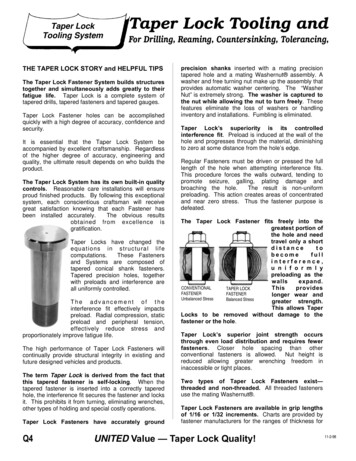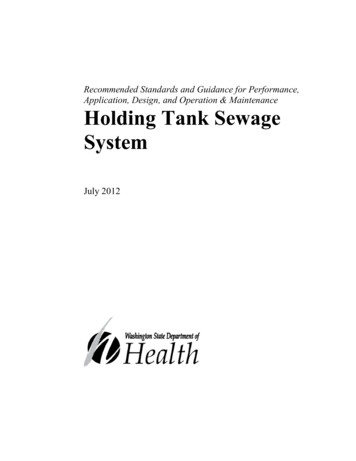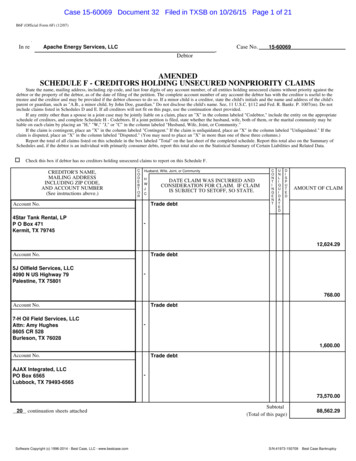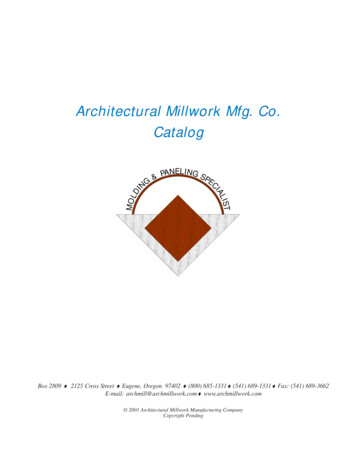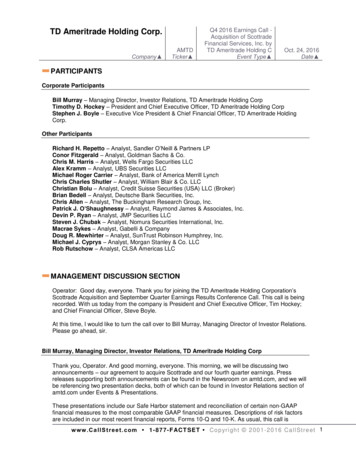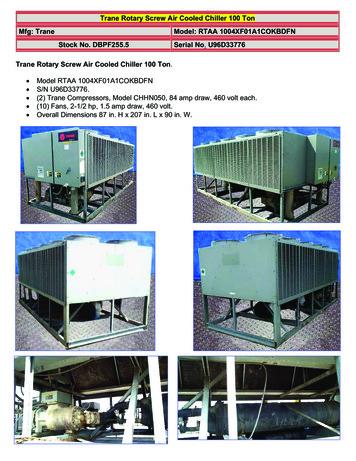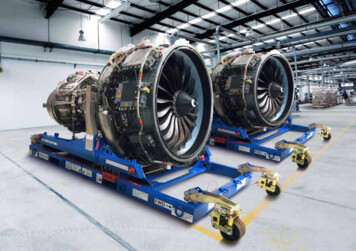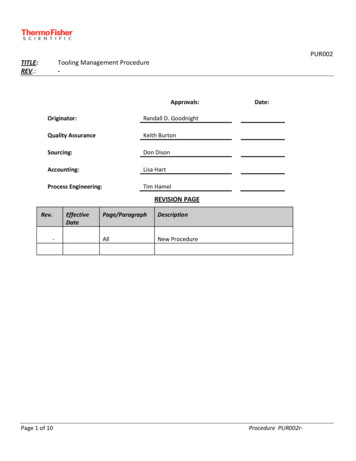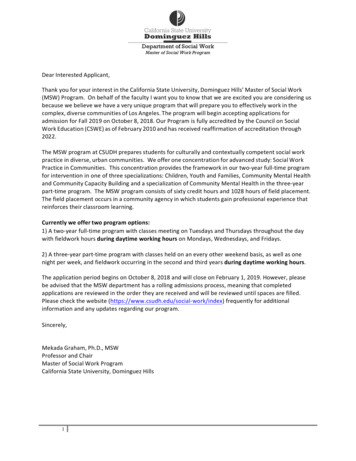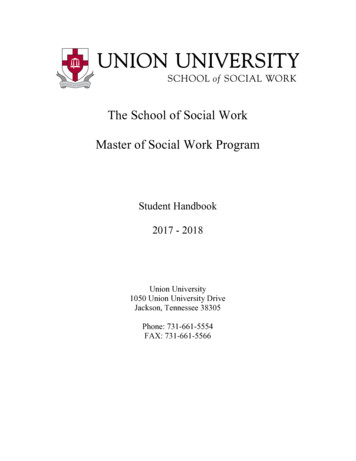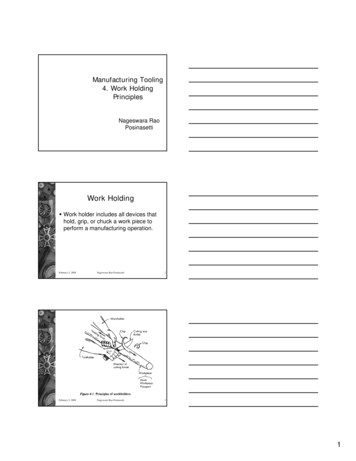
Transcription
Manufacturing Tooling4. Work HoldingPrinciplesNageswara RaoPosinasettiWork Holding Work holder includes all devices thathold, grip, or chuck a work piece toperform a manufacturing operation.February 5, 2008Nageswara Rao Posinasetti2February 5, 2008Nageswara Rao Posinasetti31
February 5, 2008Nageswara Rao Posinasetti4February 5, 2008Nageswara Rao Posinasetti5February 5, 2008Nageswara Rao Posinasetti62
February 5, 2008Nageswara Rao Posinasetti7Purpose & Function of Work Holder Location Clamping Support Cutting forces SafetyFebruary 5, 2008Nageswara Rao Posinasetti8General Considerations Physical characteristics of theworkpiece– Degree of precision– Strength and stiffness of workpiece– Production requirements– Safety requirements Standard work holdersFebruary 5, 2008Nageswara Rao Posinasetti93
Locating Principles Work piece surfaces– Flat surfaces– Cylindrical surfaces– Irregular surfaces Types of locationFebruary 5, 2008Nageswara Rao Posinasetti10Plane LocationFebruary 5, 2008Nageswara Rao Posinasetti11Concentric LocationFebruary 5, 2008Nageswara Rao Posinasetti124
Radial LocationFebruary 5, 2008Nageswara Rao Posinasetti13Combined LocationFebruary 5, 2008Nageswara Rao Posinasetti14Degrees of FreedomFebruary 5, 2008Nageswara Rao Posinasetti155
3-2-1 Method of LocationFebruary 5, 2008Nageswara Rao Posinasetti163-2-1 Method of LocationFebruary 5, 2008Nageswara Rao Posinasetti17February 5, 2008Nageswara Rao Posinasetti186
February 5, 2008Nageswara Rao Posinasetti19Concentric LocationFebruary 5, 2008Nageswara Rao Posinasetti20February 5, 2008Nageswara Rao Posinasetti217
Basic Locating Rules Position and Number of Locators Redundant Locators Locational tolerances Fool proofingFebruary 5, 2008Nageswara Rao Posinasetti22When more than one locator is placedon a surface, they should be distributedas far apart as possible on the surface When more than one locator is placed on asurface (plane), they should be distributedas far apart as possible on the surface. This would help in placing the workpiece onlocators without much skill. Also the clamping forces would not be ableto shift the workpiece from such locators. A blank with irregular surface (such as sandcasting) would be better located on suchdistributed locators.February 5, 2008Nageswara Rao Posinasetti23When more than one locator is placed ona surface, they should be distributed asfar apart as possible on the surface Machining forces would not be able todisturb the equilibrium of the workpiecein the fixture with properly distributedlocators. Wear of any locator contributes less tothe inaccuracy of location if thelocators are placed far apart.February 5, 2008Nageswara Rao Posinasetti248
While selecting the surface for thelargest locators, consideration shouldbe given to the largest area of theworkpiece. The two locators should be placed onthe surface with the next largest areaand the single locator on the surfacewith the least surface area.February 5, 2008Nageswara Rao Posinasetti25February 5, 2008Nageswara Rao Posinasetti26February 5, 2008Nageswara Rao Posinasetti279
Redundant LocatorFebruary 5, 2008Nageswara Rao Posinasetti28To prevent incorrect loadingFebruary 5, 2008Nageswara Rao Posinasetti29To prevent incorrect loadingFebruary 5, 2008Nageswara Rao Posinasetti3010
To prevent incorrect loadingFebruary 5, 2008Nageswara Rao Posinasetti31Basic types of Locators External locators– Fixed– Adjustable Threaded locators Spring pressure locators Equalizing locators Integral locators Assembled locatorsFebruary 5, 2008Nageswara Rao Posinasetti32Integral locatorsFebruary 5, 2008Nageswara Rao Posinasetti3311
Assembled locatorsFebruary 5, 2008Nageswara Rao Posinasetti34Basic types of Locators Locating pins V-locators Locating nests Adjustable locatorsFebruary 5, 2008Nageswara Rao Posinasetti35Locating pinsFebruary 5, 2008Nageswara Rao Posinasetti3612
Locator 0.5 in (Jergens)February 5, 2008Nageswara Rao Posinasetti37February 5, 2008Nageswara Rao Posinasetti38February 5, 2008Nageswara Rao Posinasetti3913
February 5, 2008Nageswara Rao Posinasetti40February 5, 2008Nageswara Rao Posinasetti41February 5, 2008Nageswara Rao Posinasetti4214
V-locator error?C"C'αOFebruary 5, 2008Nageswara Rao Posinasetti43V-locator error?February 5, 2008Nageswara Rao Posinasetti44Adjustable LocatorsFebruary 5, 2008Nageswara Rao Posinasetti4515
Support surfaces Select a surface where there is maximumlikelihood for the part to deflect under theaction of clamping and cutting forces. Support areas selected should not disturbthe location of the workpiece in any mannernor displace the locators while providing thesupport. Support areas selected should not interferewith the loading and unloading of thecomponent into the work holding fixture.February 5, 2008Nageswara Rao Posinasetti46February 5, 2008Nageswara Rao Posinasetti47Adjustable Supports Adjustable locators positioned beneaththe workpiece– Threaded– Spring– EqualizersFebruary 5, 2008Nageswara Rao Posinasetti4816
February 5, 2008Nageswara Rao Posinasetti49February 5, 2008Nageswara Rao Posinasetti50February 5, 2008Nageswara Rao Posinasetti5117
February 5, 2008Nageswara Rao Posinasetti52Internal Locators Use holes or bored diametersFebruary 5, 2008Nageswara Rao Posinasetti53February 5, 2008Nageswara Rao Posinasetti5418
February 5, 2008Nageswara Rao Posinasetti55Pin locators Plain Shouldered Undersized (0.0005 to 0.002”)– Prevent jammingFebruary 5, 2008Nageswara Rao Posinasetti56February 5, 2008Nageswara Rao Posinasetti5719
February 5, 2008Nageswara Rao Posinasetti58Diamond Pin Radial locationFebruary 5, 2008Nageswara Rao Posinasetti59February 5, 2008Nageswara Rao Posinasetti6020
February 5, 2008Nageswara Rao Posinasetti61February 5, 2008Nageswara Rao Posinasetti62February 5, 2008Nageswara Rao Posinasetti6321
February 5, 2008Nageswara Rao Posinasetti64Chip and Burr Problems Make locators easy to clean– Small and hard– Open jigs Make them self cleaning– Edge relief around locators– wipers Protect themFebruary 5, 2008Nageswara Rao Posinasetti65February 5, 2008Nageswara Rao Posinasetti6622
February 5, 2008Nageswara Rao Posinasetti67February 5, 2008Nageswara Rao Posinasetti68February 5, 2008Nageswara Rao Posinasetti6923
http://www.carrlane.com/February 5, 2008Nageswara Rao Posinasetti70http://www.carrlane.com/February 5, 2008Nageswara Rao Posinasetti71http://www.carrlane.com/February 5, 2008Nageswara Rao Posinasetti7224
http://www.carrlane.com/February 5, 2008Nageswara Rao Posinasetti73http://www.jergensinc.com/February 5, 2008Nageswara Rao Posinasetti74http://www.jergensinc.com/February 5, 2008Nageswara Rao Posinasetti7525
http://www.jergensinc.com/February 5, 2008Nageswara Rao Posinasetti76http://www.jergensinc.com/February 5, 2008Nageswara Rao Posinasetti77http://www.jergensinc.com/February 5, 2008Nageswara Rao Posinasetti7826
When more than one locator is placed on a surface (plane), they should be distributed as far apart as possible on the surface. This would help in placing the workpiece on locators without much skill. Also the clamping forces would not be able to shift the workpiece from such locators. A blank with irregular surface (such as sand casting) would be better located on such distributed locators .
